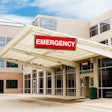Before adjourning Friday, the U.S. Congress passed a bill to establish a National Institute of Biomedical Imaging and Bioengineering (NIBIBE) by unanimous voice vote. The bill now awaits the signature of President Clinton, who, barring last-minute opposition from the NIH, is expected to sign it within the next several days.
Imaging advocates were hoping to pass the measure as part of a larger bill to fund the NIH in 2001. But opposition to the combined bills led Congress to separate the imaging institute measure from the NIH's annual budget in a special conference Friday, according to knowledgeable sources.
The Senate then passed H.R. 1795, the House imaging institute bill that was introduced in May 1999, as stand-alone legislation. The action gives the NIH a few days to attempt to dissuade President Clinton from signing the bill, should it wish to do so, while preserving the NIH's annual budget bill, also passed on Friday.
The NIH has opposed the establishment of a separate imaging institute, and provided written testimony to Congress in September stating that a separate institute would be too expensive and would waste scarce resources. Some institute supporters believe the NIH was behind Friday's successful effort to separate the bills.
Institute proponents maintain that a separate institute is essential in order to coordinate limited resources and eliminate the duplication of effort that now confounds the NIH's many competing projects. Only a centralized imaging institute can succeed in unleashing the potential of imaging and molecular medicine in the 21st century, they say.
Dr. Reed Dunnick, radiology department chair at the University of Michigan Health System, e-mailed AuntMinnie.com to say he was pleased that the bill had passed Congress, and hoped the president would sign it within 10 days as required by law.
"NIBIBE will provide a central location for imaging research which will allow us to focus and prioritize the many grants now awarded for imaging work. The existing NIH structure considered imaging research primarily as a method of testing hypotheses driven from an organ-system or disease-entity approach. The new institute will allow a portion of NIH research monies to be used to further develop the technology," Dunnick wrote.
The Washington, DC-based Academy of Radiology Research has lobbied hard to get the measure passed since it was introduced in Congress last year. In an e-mail sent to supporters this morning, academy president Dr. Douglas Maynard urged proponents of the institute to write President Clinton.
"The only step now remaining before this institute will become a reality is President Clinton's signature," Maynard wrote. "Because the NIH has opposed our bill thus far, we are now doing all we can to encourage the president to sign H.R. 1795 into law. Toward that end, e-mails to the White House from supporters throughout the country urging the president to sign the bill are critically important."
The academy's letter to the president can be signed and forwarded to the White House by clicking here. Other comments can be sent to Clinton at president @whitehouse.gov.
By Eric Barnes
AuntMinnie.com staff writer
December 19, 2000
Related Reading
House committee approves imaging institute; bill moves to final vote, September 15, 2000
Imaging institute hearing a success; legislation heads to full committee, September 14, 2000
House subcommittee to tackle proposed NIH imaging institute, September 11, 2000
More NIH funds could aid imaging effort, January 25, 2000
Radiology accelerates drive for imaging institute in 2000, January 11, 2000
Click here to post your comments about this story. Please include the headline of the article in your message.
Copyright © 2000 AuntMinnie.com

















